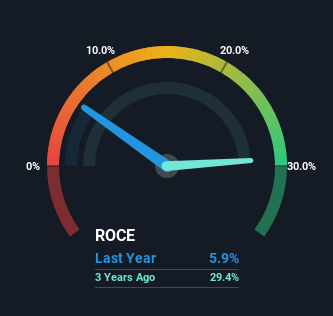Guangdong Hongxing Industrial (SZSE:001209) Might Be Having Difficulty Using Its Capital Effectively

If you're not sure where to start when looking for the next multi-bagger, there are a few key trends you should keep an eye out for. Firstly, we'll want to see a proven return on capital employed (ROCE) that is increasing, and secondly, an expanding base of capital employed. Basically this means that a company has profitable initiatives that it can continue to reinvest in, which is a trait of a compounding machine. In light of that, when we looked at Guangdong Hongxing Industrial (SZSE:001209) and its ROCE trend, we weren't exactly thrilled.
Return On Capital Employed (ROCE): What Is It?
For those who don't know, ROCE is a measure of a company's yearly pre-tax profit (its return), relative to the capital employed in the business. To calculate this metric for Guangdong Hongxing Industrial, this is the formula:
Return on Capital Employed = Earnings Before Interest and Tax (EBIT) ÷ (Total Assets - Current Liabilities)
0.059 = CN¥83m ÷ (CN¥1.8b - CN¥349m) (Based on the trailing twelve months to March 2024).
So, Guangdong Hongxing Industrial has an ROCE of 5.9%. Even though it's in line with the industry average of 6.4%, it's still a low return by itself.
Check out our latest analysis for Guangdong Hongxing Industrial

Historical performance is a great place to start when researching a stock so above you can see the gauge for Guangdong Hongxing Industrial's ROCE against it's prior returns. If you want to delve into the historical earnings , check out these free graphs detailing revenue and cash flow performance of Guangdong Hongxing Industrial.
What Can We Tell From Guangdong Hongxing Industrial's ROCE Trend?
On the surface, the trend of ROCE at Guangdong Hongxing Industrial doesn't inspire confidence. Around five years ago the returns on capital were 30%, but since then they've fallen to 5.9%. However, given capital employed and revenue have both increased it appears that the business is currently pursuing growth, at the consequence of short term returns. And if the increased capital generates additional returns, the business, and thus shareholders, will benefit in the long run.
On a related note, Guangdong Hongxing Industrial has decreased its current liabilities to 20% of total assets. So we could link some of this to the decrease in ROCE. What's more, this can reduce some aspects of risk to the business because now the company's suppliers or short-term creditors are funding less of its operations. Since the business is basically funding more of its operations with it's own money, you could argue this has made the business less efficient at generating ROCE.
The Bottom Line On Guangdong Hongxing Industrial's ROCE
Even though returns on capital have fallen in the short term, we find it promising that revenue and capital employed have both increased for Guangdong Hongxing Industrial. These growth trends haven't led to growth returns though, since the stock has fallen 35% over the last three years. So we think it'd be worthwhile to look further into this stock given the trends look encouraging.
One final note, you should learn about the 3 warning signs we've spotted with Guangdong Hongxing Industrial (including 2 which are a bit unpleasant) .
If you want to search for solid companies with great earnings, check out this free list of companies with good balance sheets and impressive returns on equity.
New: Manage All Your Stock Portfolios in One Place
We've created the ultimate portfolio companion for stock investors, and it's free.
• Connect an unlimited number of Portfolios and see your total in one currency
• Be alerted to new Warning Signs or Risks via email or mobile
• Track the Fair Value of your stocks
Have feedback on this article? Concerned about the content? Get in touch with us directly. Alternatively, email editorial-team (at) simplywallst.com.
This article by Simply Wall St is general in nature. We provide commentary based on historical data and analyst forecasts only using an unbiased methodology and our articles are not intended to be financial advice. It does not constitute a recommendation to buy or sell any stock, and does not take account of your objectives, or your financial situation. We aim to bring you long-term focused analysis driven by fundamental data. Note that our analysis may not factor in the latest price-sensitive company announcements or qualitative material. Simply Wall St has no position in any stocks mentioned.
About SZSE:001209
Guangdong Hongxing Industrial
Manufactures and sells knitted apparel in China.
Excellent balance sheet slight.
Market Insights
Community Narratives



